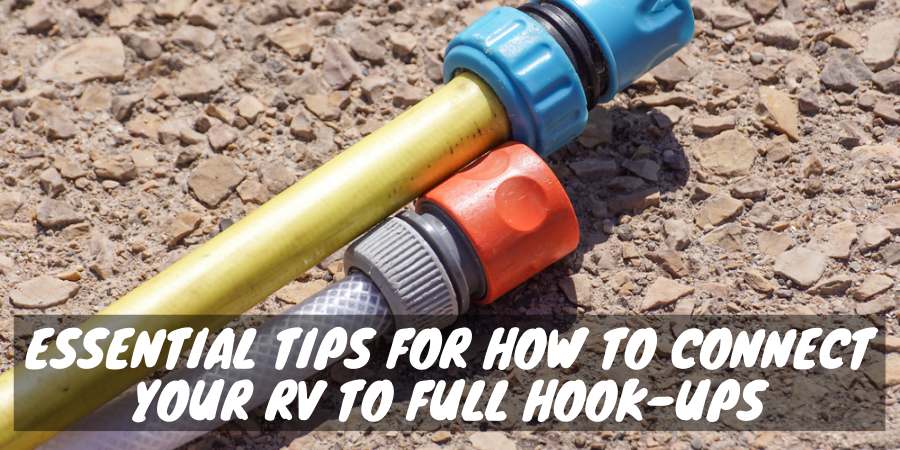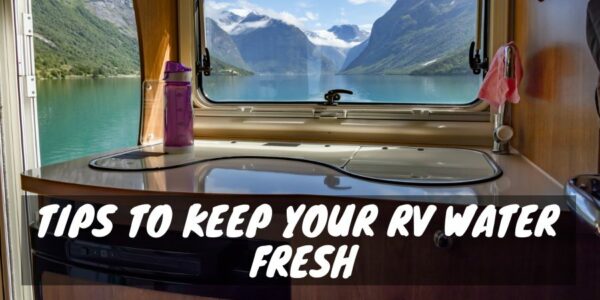RVing requires learning how to empty wastewater tanks without making a big mess.
Dealing with black water tanks for solids from the toilet and grey tanks for sink and shower water can be a hassle when you don’t know what you’re doing.
Luckily, using a few tricks and tips, like the ones here in the guide to RV sewer hookups, you can avoid a stinky experience.
I’ll give you a fast yet efficient routine to empty your RV waste tanks, along with tips to prevent clogs or buildup that create problems.
Don’t be “that guy” at the campground whose RV sewer system reeks. Learn to hook up and dump your camper waste tanks correctly right here!
RV Black and Grey Water Tank Dumping Pre-Game
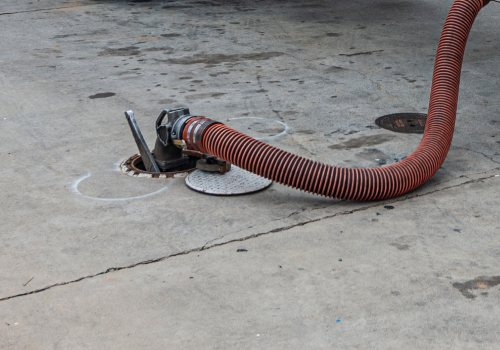
Before your camper’s waste tanks are full and need dumping, you should have a complete sewer dumping kit ready to go that includes:
- RV sewer hose
- RV sewer hose kit
- Rubber gloves (optional)
- Sewer drain fittings
- Hose or clean water supply
- Rags or paper towels and disinfecting cleanser
Many people wonder how long an RV sewer hose should be, and my answer is — a minimum of 15 feet. This length should be sufficient to reach connections at 99% of campgrounds that offer sewer at the campsite.
TIP #1: Invest in a rugged sewer hose and adapters with bayonet fittings for the fastest way to connect for dumping. High-quality RV sewer components won’t tear, bend, crack, or leak like cheap versions.
TIP #2: Always carry a sewer drain donut along with a universal sewer drain fitting. Sometimes, you’ll encounter sewer drain pipes that are broken or jagged, making it difficult to attach your standard fitting.
Placing the donut over the damage and then sticking your normal sewer drain fitting inside the donut works wonderfully in a pinch to seal off any gaps to keep fluid from spraying out and odors from escaping.
The last part of your pre-game checklist is to ensure your gray tank is at least half full and your black tank 2/3 full before dumping.
You’ll require plenty of liquid to disperse any solids in the black tank so it can flow out without clogging. The force of the greywater will ensure a good rinse of the sewer hose with mostly soapy water.
TIP #3: If your tanks aren’t full enough, run some water or flush the toilet until they are.
How to Correctly Connect RV Sewer Hookups
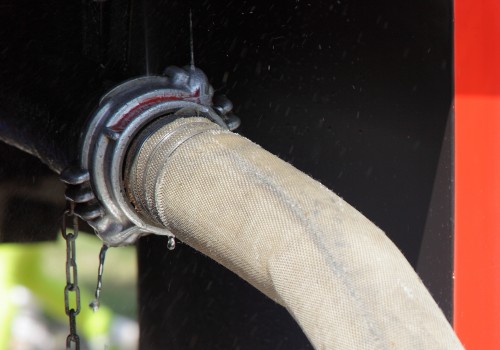
Creating a routine for setting up your sewer hoses for dumping is the best way never to forget any steps.
For those who camp at National Parks or other places that don’t have campsite sewer drains and only dump stations, the steps below will still apply. You can skip using the hose support to save time, as often there’s a line of campers waiting to use the station.
After years of trying different methods, I now follow this routine:
Step 1: Pull out the sewer hose and lay it on the ground between the RV and the sewer drain.
TIP #4: This is an excellent time to do a visual inspection of the hose for damage. If you do catch a small tear or hole, you can patch it with a bit of Eternabond tape (or a similar product) until you can replace the hose.
Step 2. Remove the sewer cap and securely attach the fitting into the sewer drain.
Step 3. Stretch out your sewer hose support.
TIP #5: If your support isn’t long enough to provide a good angle to reach the drain, a short section of plastic rain gutter is an excellent way to extend the hose support.
A two or three-foot section of gutter is lightweight and easy to store in the camper’s basement. You can stack and carry several to be ready for anything and can use rocks or blocks of wood to elevate them to your liking.
Step 4. Connect the sewer hose to the sewer drain fitting, then walk toward your RV while lifting and laying the hose into the support track.
Step 5. Connect the other hose end to your RV’s sewer pipe discharge.
TIP #6: Putting a clear adapter onto the end of your RV discharge pipe can help angle the hose in the direction you wish while also allowing you to see that your tanks are emptying fully.
A transparent fitting is a must if you plan to clean or backwash your RV black tank during your trip so you can see that the water is running clear without any more debris.
RV Quick Tip – How to Connect to Full Hook-UPS (Video)
Easy Steps to Dump Your RV’s Black and Grey Water Tanks
Now that your hose and fittings are in place, it’s time to dump your RV waste water tanks following these steps:
Step 1. Locate and slowly pull open the black water valve.
Quickly pulling open the valve causes a big rush into your hose and pop loose a connection that isn’t secure. A slow, steady pull helps the flow “settle in” and allows you to check for leaks down the line.
TIP #7: Always have a second person on hand during sewer dumps when possible.
You really should have one person at the sewer drain using their foot to hold the fitting in place as the wastewater passes through to stop it from accidentally popping off.
Once the other person opens the valve, they can walk the line and look for leaks in the hose or make adjustments to the support track so things flow correctly. A team makes this part of the process go much more smoothly.
Step 2. After the black water tank is empty, shut the valve.
Step 3. Open and drain the grey water tank and shut the valve.
Step 4. You can opt to leave your sewer hose in place for future wastewater dumps, depending on how long you plan to camp.
If so, ensure both grey and black valves are shut tightly, and you’re done for now.
If you plan to remove your sewer hose and fittings, remove the hose from the camper’s discharge pipe and hold the hose up.
Step 5. Run clean water into the hose.
Dump a clean bucket of water into the open end of the sewer hose or use a garden hose (do not let the garden hose touch any part of the sewer hose). This step flushes out any debris or dirty wastewater into the sewer line drain. Again, having a second person to help with this task makes it easier.
Step 6. Walk toward the sewer drain while keeping the hose elevated to push any remaining fluid down into the sewer drain.
TIP #8: While walking and draining, start collapsing your sewer hose so it’s shorter and easier to manage. This is a great reason to only buy a collapsible RV sewer hose.
Step 7. Unhook the other end of the sewer hose from the drain fitting and remove the fitting from the pipe. Return the cap to the top of the drain.
Step 8. Restore the caps to the ends of the black and gray water discharge pipes. Tuck away the sewer hose into the bumper, rinse off all the adapters or fittings, and put them back into storage.
Step 9. Remove and toss your disposable gloves or wash and disinfect your hands and any other body parts that came in contact with the sewer components.
TIP #9: I always fill a bucket with clean water and some bleach and toss in my sewer fittings for a few minutes to kill any germs before storage. I then dump this down the sewer drain before capping off the line.
Can You Leave Your Grey Water Tank Open?
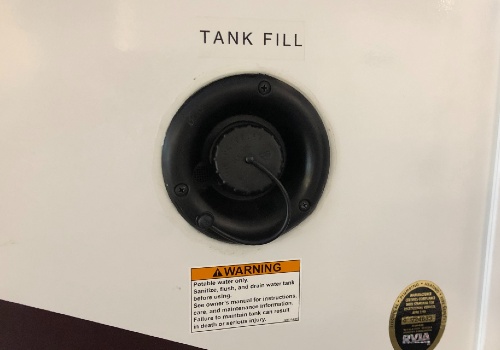
Yes, you can leave your grey water tank open if you wish, but in most instances, it’s better only to dump it when it’s full.
Why?
Because you can use the greywater to rinse out the sewer hose after dumping the black water tank, the water pressure can break free any partial clogs inside the sewer hose.
When can you leave the grey water tank open?
People who camp in one location for extended periods and shower often can leave the valve open so that greywater can drain immediately.
Leaving the sewer hose connected and open is a convenient way to avoid overfilling the tank and flooding the camper, or dumping the tank frequently.
But before you opt to go this route, follow these tips:
TIP #10: Make sure you use a sewer hose support to keep the flow at a good angle. Many campgrounds require support anyway, so having one is smart.
TIP #11: To avoid sewer gas back-draft (and sewer bugs!) in your camper, create a P-trap in the hose by creating a U-shape in the sewer hose anywhere along the line before it gets to the drain.
Open one section of the hose support as wide as you can, and allow the hose to drop down to the ground and back up onto the support. You may need to use a zip tie to secure the hose in place.
This low section of hose fills with greywater to create a trap.
RV Sewer System: Troubleshooting the Biggest Black Tank Problem
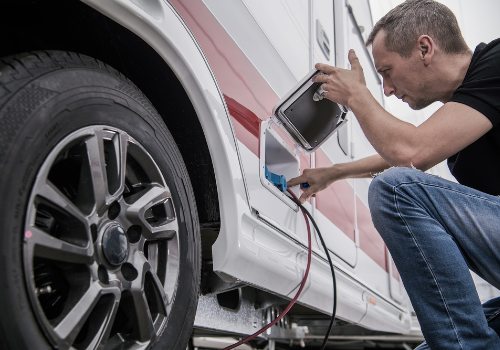
A best RV sewer hookup won’t help you drain out waste (and stench) entirely from your camper if the black tank forms buildup, such as the infamous “pyramid” below.
What Is an RV Poop Pyramid, and How Do You Avoid It?
Want to Connect With a Community of Over 1,078 RV Enthusiasts?
Do you poop in your RV? If so, you’ll find that it’s relatively easy to create a pyramid of poop and toilet tissue inside your black water tank.
RV black tanks are long, flat boxes with a drain pipe on one end. The toilet flange opens and drops waste directly into this tank.
If there isn’t enough fluid in the tank, the bottom remains dry enough to catch poop and toilet paper under the flange spot.
If you aren’t traveling about and shaking this mass loose, it will stick there.
Every time you continue to use the toilet, even if it’s just urine and TP, any solids will settle on top and eventually build a pyramid of yucky waste.
I’ve seen RV newbies create a pyramid so tall it hit the toilet flange!
Without consistent black tank cleaning, even small pyramids of poop can emanate a stench in an otherwise clean tank and cause stubborn pipe or hose clogs when they break loose.
How to Avoid Waste Build up Inside Your RV Black Tank
It’s not difficult to avoid creating a pyramid of waste inside your RV black tank by using these three tricks:
- Add water after dumping the tank
- Use RV black tank chemicals
- Don’t flush TP
BLACK TANK WATER FILLING AFTER EACH DUMP
Always remember to add enough water into your black tank after you dump it and before use.
You can dump in buckets of water and hold the flush pedal down on your toilet until enough water fills.
I use the flush pedal when I’m on campground water but switch to a bucket at a dump station.
Take a flashlight, open the flush flange on the toilet, and peek down into the tank if you can (some RVs have bends in their toilet drain) to see how much water is in the tank if you’re unsure.
USE THE RIGHT RV WASTE WATER TANK CHEMICALS
There are two types of RV sewer waste tank chemicals: those that focus on reducing odor and those that work to dissolve the solid waste.
Always choose a dissolving chemical blend, even if you never poop in your camper or add TP to the toilet.
The chemicals or microbes in RV black tank cleaners do an excellent job of breaking down material floating in the fluid or stuck to tank walls, making it easy to flow out the sewer hose when you dump your tank.
JOIN THE NO TOILET PAPER FLUSH CLUB
When it comes to flushing toilet tissue in a recreational vehicle, it’s about fifty-fifty split between those that do and those that don’t.
Many people prefer to avoid general clogging of sewer lines by not adding TP to their tanks.
#12 BONUS TIP: Don’t waste money on expensive, RV-friendly, quick-dissolving toilet paper.
With good black tank chemicals to control small, any brand of TP will dissolve in water, as shown in this video. Buy the toilet paper you like if you plan to be in the prefer-to-flush club.
Please be aware to never put pipe-clogging flushable wipes down the toilet as these won’t disintegrate for months, if not years, and can back up campground sewer lines, causing havoc for all the guests!
Final Thoughts
A free-flowing RV septic system is not hard to master when you know the tricks to keep wastewater tanks and sewer hoses clean and clear.
I hope using the information above helps you eliminate problems dealing with proper tank dumping so the task can be over with quicker and with less mess.
A good tank-dumping routine not only helps campgrounds maintain clog-free sewer lines but also keeps your RV septic system working correctly and smelling fresh!
How to Setup Camp at a Full Hookup Campground (Video)
"Man cannot discover new oceans unless he has the courage to lose sight of the shore."
-- Andre Gide

